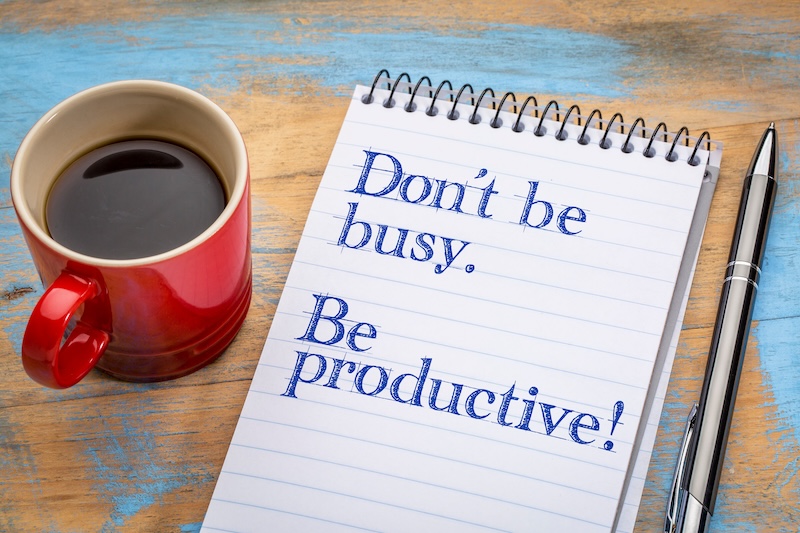Ah, April! It’s an energizing month, with the landscape greening and the days lengthening.

You or other members of your team may have recently returned from ISPA EXPO with a long list of follow-ups and to-dos. This time of year, mattress factories are busy churning out new products introduced during the winter Las Vegas Market and readying for what is hopefully a strong summer of sales. April also brings with it strong spring-cleaning vibes: It might be time to clear the clutter on your desk or deep clean a messy part of your facility.
With all that in mind, we’ve rounded up a bevy of hacks, tips, suggestions and resources from productivity podcasters to help you make the best use of your time and better organize your life. Check out our socials for a list of top productivity podcasts: LinkedIn, Facebook, and Instagram.
Before we get started, one note: We’re not diving into apps and other tools. There are countless paper products and digital systems for both Android and Apple, and what works best for each person is often a matter of trial and error. But we encourage you to explore your options.
Master Your Schedule: Powerful Planning Strategies
Begin your day the night before
Several productivity experts note that how your morning goes is determined, in no small part, by how the previous night went. If you want to start your day refreshed and energized at 6 a.m. and you need eight hours of sleep, you probably need to start unwinding around 9 p.m. and head for bed by 10 p.m. (BedTimes’ monthly Nightcap Q&A, which queries bedding industry leaders about their nighttime routines and sleep habits, is full of good tips).
Start the day with a plan
Taking 10-15 minutes at the start of your day to review your calendar, to-do list and priorities can help you anticipate any potential problems and punt items to the next day, if needed. Or you might see that the day is shaping up to be a light, flexible one, and you may decide to address something you’ve been putting off.
Break down annual goals
Planning expert Sarah Hart-Unger uses a nested goal system, in which she sets goals for the year, quintiles (rather than quarters), months, weeks and days. The method, she says, helps break large goals into smaller tasks and helps ensure progress.
Put planning days on the calendar
Hart-Unger also recommends setting dates with yourself (and perhaps team members) to assess goals and look ahead to the following month or season. Take a moment right now to put regular planning dates on the calendar through the end of the year.
Track Your Time & Optimize Workflow
Track your time
Laura Vanderkam, host of the productivity-focused podcasts “Best of Both Worlds” and “Before Breakfast,” has been tracking her time every day for years and encourages her listeners to do the same with occasional time-tracking challenges. The exercise can help you reconcile how you actually spend your time with how you want to spend your time and highlight inefficiencies in your day.
Block your time
It’s one thing to have a to-do list. It’s another thing to set aside time to get the things on that list done. Productivity expert Cal Newport is a proponent of dividing your day into distinct chunks, including time for deep work or deep thinking, arguing that people who use his method are twice as productive as people who don’t. He and other companies offer planners designed specifically for time blocking.
Build in buffers
If you have an hour-long meeting at 2 p.m., you probably block out 2- 3 p.m. on your calendar. Even if it’s a meeting down the hall or via Zoom, you can benefit from adding 5-15 minutes of buffer time before and after. Use that time to gather your thoughts, use the bathroom, refill your water bottle or decompress from the meeting beforehand. By adding extra time around meetings and appointments, you’ll feel less frazzled and more focused.
Leave time open
If your job involves a lot of problem-solving and crisis management, leave a few hours open each day to deal with issues that have arisen. It may feel awkward at first to have open space on the calendar, but the dedicated time will leave you less stressed than trying to squeeze emerging matters into a jam-packed calendar, Vanderkam suggests. And if no emergencies arise, you can tackle items on your to-do list and get ahead for the next day.
Make a plan for random pockets of time
A meeting might be canceled, or a phone call might be postponed. Kendra Adachi, author and host of the “The Lazy Genius” podcast, says such occurrences lead to “random pockets of time” and suggests putting those to good use by always having a plan for what to do when they occur in your day. Maybe you always use that time to catch up on email or check in with customers.
Prioritize & Conquer: Mastering To-Do Lists
Keep your list in one place
If you’re in a hurry, it’s tempting to jot down a to-do on a random Post-it notes, email it to yourself, make a voice memo or, worst of all, think you’ll remember it later. That can lead to forgotten tasks and a surfeit of confusing lists. Where and how you keep your to-do list matters less than keeping one central list, productivity experts say. If you do need a way to capture an idea before it can be added to your central list, use the same method each time. For instance, always write it on that Post-it note or always do a voice memo and then set aside time each day to move those notes onto your primary to-do list.
Narrow your to-do list daily
Your central list might have dozens of items on it — and you’re not going to get to them all tomorrow. The guidelines vary but productivity experts agree that your daily to-do list should have no more than 2-6 priorities on it, depending on how time-consuming each one is. If, at the end of the day, there’s something you haven’t accomplished, move that item to the top of the list for the next day.
Use your goals to create your to-dos
It’s easy to fill your days with busy work that might make you feel productive but doesn’t help you accomplish the big goals you want to achieve. Review your monthly and weekly goals to create your daily to-do list and you’ll achieve more than you can imagine.
Organize for Success: Taming the Chaos
Do a spring clean of your workspace or office
And be ruthless about what stays and what goes. Just as home organizing specialists recommend when cleaning out clothes closets, think about the last time you used or referred to an item. If it’s been more than a year, it can probably go. If you’re still reluctant to toss something, put it in a box, seal and label it with the date a year from now. If you haven’t opened the box by then, toss it. Another good criterium to use: If it’s paper, is the same information available online now? If so, it can probably go.
Practice the purge
You can accumulate as much junk on your devices as you can in a file cabinet, slowing down their performance and making it hard to find what you need. Once or twice a year, take time to delete old files, videos and photos or move them to an external hard drive. (Pro tip: This is a great task to tackle while sitting in an airport. If you want to spread it out over time, make it your go-to habit during those random pockets of time.)
Tame your email
Set aside 30 minutes a day to plow through email or tackle it in 10-minute sessions three times a day. Take advantage of features that allow you to direct incoming emails directly into specific folders. Or, as Hart-Unger recommends, abandon folders and just archive old emails. The search function on most email programs makes it easy to search for a specific email later, she notes. And be brutal about unsubscribing to newsletters and other items you rarely read.
Read more Sleep Savvy articles on how to become a better manager, Maximizing Your Feedback.







